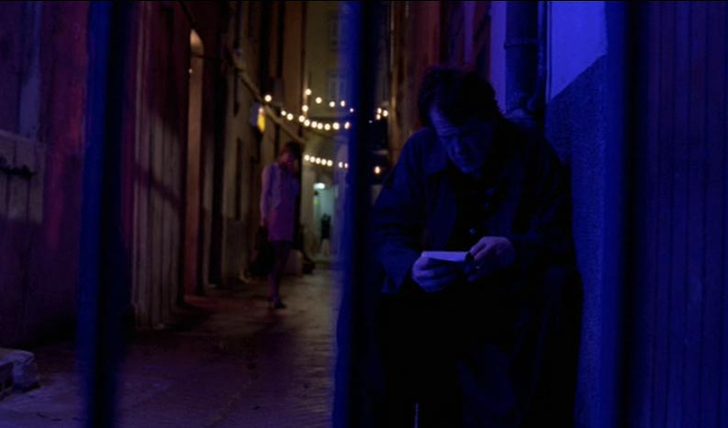 How does Neil Jordan keep getting better and better? When he made The Crying Game, the ultimate gimmick film of the 1990s, he was already pretty good, having put Mona Lisa under his belt years before, not to mention a terribly serious (I’d say too serious) horror film, The Company of Wolves. He followed The Crying Game with a terrible misfire, Interview with the Vampire. I skipped Michael Collins, fearful of spending 133 minutes stuck in a dark room with a director I now thought of as “Hollywood” Jordan. But 1997’s The Butcher Boy is a surprisingly wonderful picture, full of playful narrative tricks and yoking a truly sardonic sense of humor to a killer performance by a very young actor. Of course, he followed that up with the wretched In Dreams. And then followed that up with the lovely, understated The End of the Affair. He’s a stylist who must have gained bucketloads of experience from his dreadful pictures, thereby helping him keep the good ones on target.
How does Neil Jordan keep getting better and better? When he made The Crying Game, the ultimate gimmick film of the 1990s, he was already pretty good, having put Mona Lisa under his belt years before, not to mention a terribly serious (I’d say too serious) horror film, The Company of Wolves. He followed The Crying Game with a terrible misfire, Interview with the Vampire. I skipped Michael Collins, fearful of spending 133 minutes stuck in a dark room with a director I now thought of as “Hollywood” Jordan. But 1997’s The Butcher Boy is a surprisingly wonderful picture, full of playful narrative tricks and yoking a truly sardonic sense of humor to a killer performance by a very young actor. Of course, he followed that up with the wretched In Dreams. And then followed that up with the lovely, understated The End of the Affair. He’s a stylist who must have gained bucketloads of experience from his dreadful pictures, thereby helping him keep the good ones on target.
It doesn’t hurt that I’m a sucker for a pretty picture, and Jordan here seems to be striving to create a Hollywood equivalent of a Wong Kar-Wai film. I’m not saying he gets there — Wong Kar-Wai is flat-out one of the greatest filmmakers living, and Jordan is merely increasingly excellent. But he manages to take some of the big clichés of contemporary moviemaking — the stutter-step slo-mo effect that’s so in vogue these days, and the rampant exploitation of digital post-production processes — and make them feel graceful, if not always profound. The camerawork is elaborate and deliberate, with Jordan putting the camera in the back seat of a car and swiveling it like a rubbernecking passenger, or having it suddenly whip around from a profile to face a character dead on. The photography is uniformly lovely. The split-second still frames that terminate a large number of sequences here could be called a distraction, but I took them as a reminder of the presence of a storyteller, indulging his satisfaction with the unspooling drama and punctuating the character notes with just a little more brio than is absolutely necessary.
Speaking of storytellers, Nick Nolte is saddled with too much narrative burden, including the obligatory expository scene in which he tells a Bible story that explicates the title of the film. (In the age of Google, I gotta wonder whatever happened to forcing the audience to do just a little bit of research for themselves.) Doing a Tom Waits impression, he grumbles and harrumphs his way from down-and-out to back-on-top, cutting off a long-standing affair with smack and eventually strutting around Monte Carlo in a perfectly fitted monkey suit. This is a very good thing: suddenly, the costume design manages to lift an enormous burden from the picture, allowing it to concentrate on deftly raising those questions specific to the heist thriller. Who knows what’s going down? What do the cops think they know? And what element of the plan is about to go terribly wrong?
The Good Thief is a real heist picture, not some post-modern consideration of the same, so the film won’t reward viewers who are impatient with the genre conventions it dutifully covers. Some of the dialogue just rings false (and it doesn’t help that the sound recording, apparently extensively post-synced, seems to have been a very tertiary consideration). But Nolte’s titular scoundrel, clambering toward a state of grace that only movie directors can grant, is just credible enough; the appearance of a framed photograph of the actor in his youth helps give him the leverage he needs to play tragic, though we never see him in the moments of quiet reflection that you might expect. The story is always about how he bounces what remains of his energy off other people, calculating their level of credulity and then using it against them. The question is whether he can make it out of this morass without actually screwing anybody he cares about. (That includes Nutsa Kukhianidze’s 17-year-old hooker, whose confusion over her attraction to Nolte as a father figure with a desire to fuck him, makes her an avatar of redemption for the old man.) As moral quandaries go, it’s a pretty good one.
